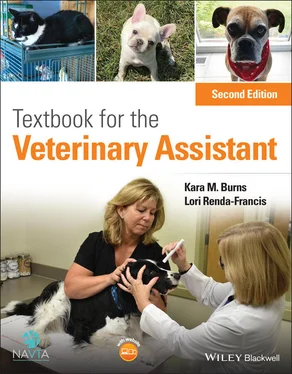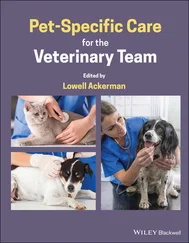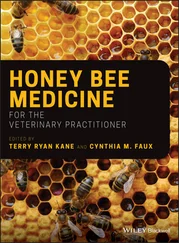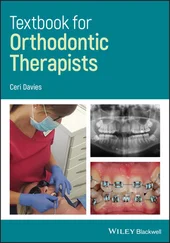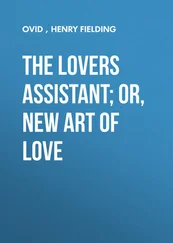Fearful or aggressive dogs must be removed with caution from a cage or kennel. Common sense plays a huge role in the removal and restraint of aggressive dogs. The health‐care team should muzzle or sedate an aggressive dog prior to placing it in the cage. The dog is protecting its territory, so cornering it will make it feel threatened. This is the perfect time to use voice as a restraint aid and offer approval and comfort. The use of a capture pole may be warranted, especially in instances where the dog is attacking the leash or the area of the kennel in which the team member is standing.
Lifting and positioning a dog
Always bend at the knees to pick up an animal. Do not bend over at the waist, as you put yourself at increased risk for back injury. Working with animals requires strength and proper posture. All health‐care team members must adhere to proper lifting techniques for the good of the individual, team members, and patient. After bending at the knees and keeping your back straight, you can lift a small‐breed dog by placing one hand under its mandible and your forearm under its abdomen. The dog should be carried close to your body for stability at all times. Medium‐sized dogs should be held with one arm under the neck and the other arm under the abdomen or around the dog’s hindquarters. For the safety of the pet and the safety and health and longevity of the team members, lifting large‐breed dogs requires two team members who must communicate and work together to insure safety. One person should place his or her arm around the dog’s thorax and the other arm under the dog’s neck. The other person should place one arm under or around the dog’s abdomen and the other arm around the hindquarters.
Placing a large dog on an exam table may produce anxiety for the animal, so the health‐care team should attempt to examine the dog on the floor. Alternatively, hydraulic lift tables are becoming more popular. The dog may be placed on the table at ground level and secured, with health‐care team members readily on hand. The table can then be raised to a level that allows the team to examine the dog.
Restraint while standing is necessary when the dog is undergoing a physical examination, anal sac expression, having its temperature taken rectally, or if a vaginal or rectal smear must be obtained. Restraint for these procedures involves placing one arm around the dog’s neck or muzzle and the other arm around the dog’s body. The dog must be pulled in close to the team member’s body. Large and giant‐breed dogs will require two team members to participate in the restraint. The restraint should not be a tight stranglehold on the dog but rather a tender hold with some softly spoken words. A tender hold with a well‐behaved patient was all that was needed during the physical examination in Figure 4.5. The health‐care team members must be ready at all times to tighten the grip if the patient starts to struggle or become aggressive.
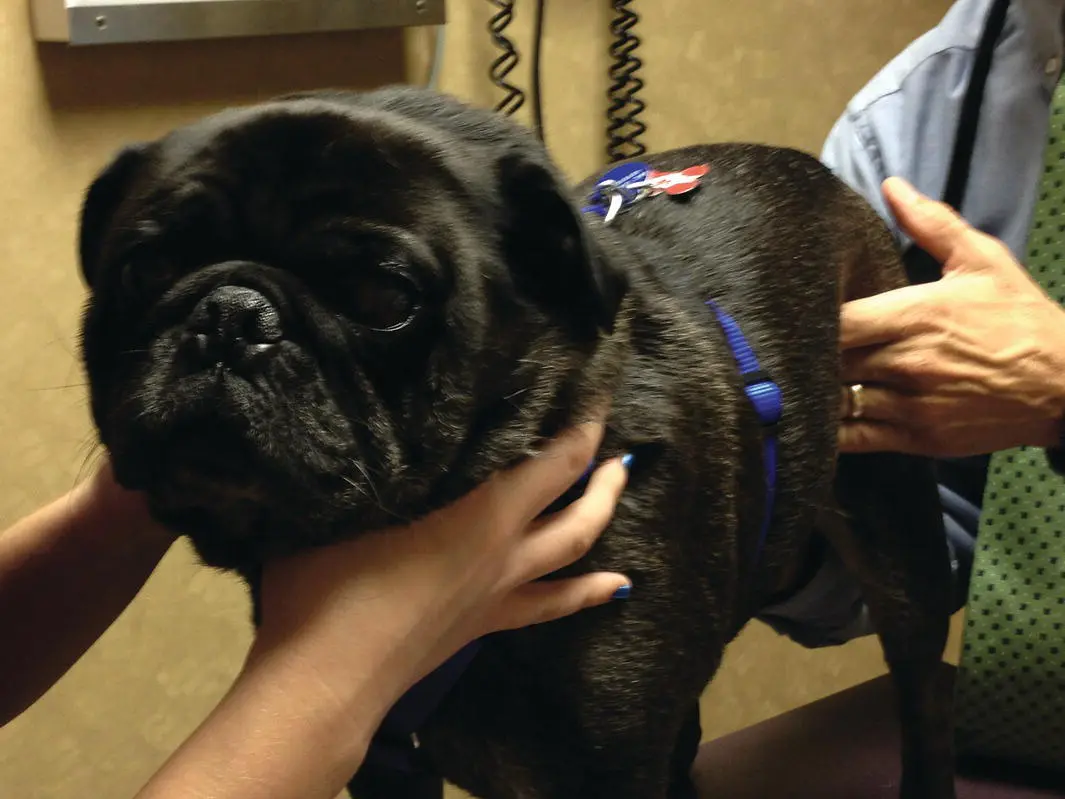
Figure 4.5 Tender hold during physical examination.
Source: Courtesy of Kara M. Burns, LVT, VTS (Nutrition).
Using recumbent restraint is necessary for many procedures. Procedures such as drawing blood from a cephalic or jugular vein, administering an IV injection, oral and ophthalmicexamination, and administering medications are a few of the procedures that warrant restraint in sternal recumbency. In this kind of restraint, the health‐care team member places one hand under the neck or muzzle region of the dog and the other around the hindquarters and pulls the dog in close to their body. If the dog is trying to scratch with its front paws, the team member can remove the arm from around the hindquarters and wrap it around the abdominal area with the hand coming from the underside of the dog to the front legs. The front legs should be grasped slightly above the carpal area.
Placing a dog on its side will allow for restraint in lateral recumbency. With the dog on its side, the front legs are held while the team member places one arm across its neck. The other hand is used to hold the back legs. This is a useful restraint for urinary catheterization,radiographs, suture removal, and for access to the lateral saphenous vein.
Restraint in dorsal recumbency calls for two team members. The dog is placed in lateral recumbency and is carefully rolled onto its back. The front paws are extended cranially with the back paws extended caudally. This exposes the thorax and abdomen of the dog. A V‐trough or foam wedges may be necessary to prevent the dog from rolling. This technique is often used for radiographs or cystocentesis.
Prior to their domestication, cats were known to be solitary animals that follow an organized social structure. Cats are also known to be very territorial. In today’s society, cats often live indoors and with other cats. Cats can and do get along with other cats, but they have a vast array of communication behaviors of which the health‐care team should be well aware. Some of these behaviors are listed below.
Relaxed – the cat walks with its tail down, but its tail will rise when it greets other cats and humans it knows.
Fear aggression – the tail will be held close to the body and oftentimes will be fluffed (to give the appearance of being bigger). The pupils are often dilated.
Aggression – the ears are swiveled, displaying the inner pinnae sideways, and the pupils are oblong.
Frightened – the dorsal area will be arched and the tail raised. Again, the fur along the back and covering the tail will be fluffed to give the appearance of being larger and more intimidating.
Facial expressions of a feline
Relaxed – ears are upright, whiskers are on the side of the face, pupils of eyes are moderately dilated ( Figure 4.6).
Aggressive – ears are erect and facing back; pupils are constricted.
Frightened – ears are flat against the head, whiskers are held stiffly out to the side, and the pupils are dilated.
Conflicted – ears will alternate between the flattened and turned‐back position.
Alert – pupils are dilated, and whiskers are tensed.

Figure 4.6 Relaxed cat facial expression.
Source: Courtesy of Kara M. Burns, LVT, VTS (Nutrition).
For cats, scratching is a visual sign of territory ownership. The cat marks the area with the glands present around the paw pads. Scratching leaves a visual sign of territory ownership and maintains the claws.
Meows – expression of needs to owners (often associated with feeding).
Loud yowls – typically heard from queen in heat.
Growling – range in volume; often in conjunction with aggression or fright.
Purring – humans generally believe this is a sign of contentment, but it can also be a sign of low‐grade pain.
Other feline body language
Glands on facial area – the cat deposits secretions when it rubs itself on an object to be marked.
Urine – sprayed by male cats at the height of the cat’s nose, to mark territory for the next cat coming to the area.
Feces – the cat may bury or leave feces to alert other cats to its territory.
Читать дальше
